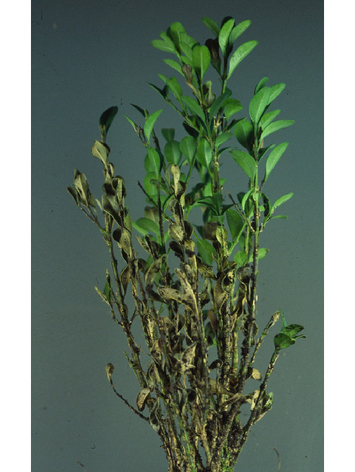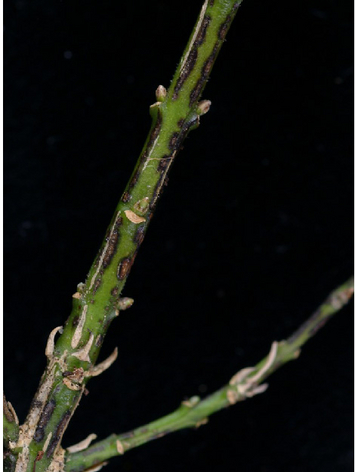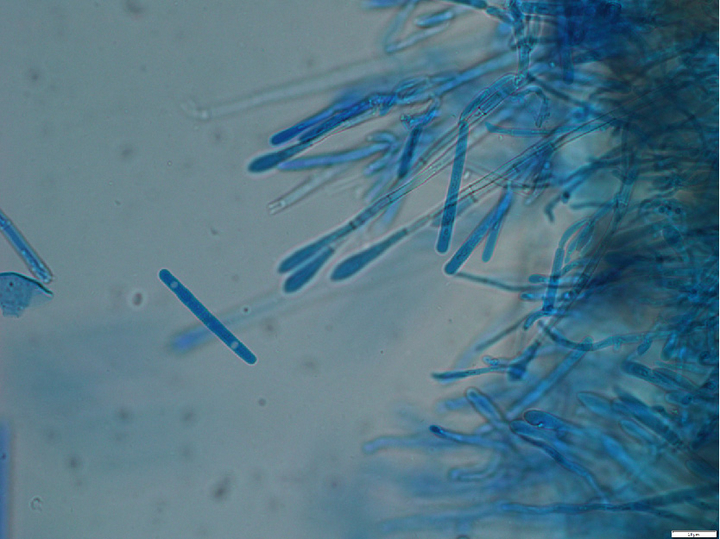Box blight
Cylindrocladium buxicola B. Henricot
Biology
Cylindrocladium buxicola can infect boxwood plants both via wounds and via the intact cuticle of the leaves. However, it requires leaf wetness for this, and a period of five to seven hours is sufficient. The infestation is favored by warm, humid weather. The optimum temperature is 25°C, but mycelial growth can begin even at 5°C. High temperatures are not tolerated well. High temperatures are not well tolerated, because above 30 °C the fungus stops growing and at temperatures above 33 °C it dies. By means of the permanent spores (chlamxdospores) formed, the fungus can survive in the soil for at least four years.
Damage symptoms


Symptoms on the boxwood are striking. Initially, on the younger leaves are found small brownish spots, which have a dark edge. As the disease progresses, the leaves turn brown, leaf drop occurs, and entire shoots die. With sufficient moisture, a white spore coating forms on the undersides of the leaves. Very dark, almost black, streak-like lesions form on the shoots.
Host plants
Only species of the genus Buxus are attacked. Studies have shown that there are differences in susceptibility among different species and varieties of boxwood. For example, Buxus sempervirens 'Suffruticosa', 'Rotundifolia', 'Handworthiensis' and 'Raket' are considered highly susceptible, while Buxus sempervirens 'Blauer Heinz' is susceptible. The cultivars 'Arborescens', 'Elegantissima' and 'Herrenhausen' and Buxus micorphylla 'Faulkner' are considered relatively resistant. Densely planted bed borders and plants cut into spheres or figures are particularly at risk, as leaf wetness can be retained particularly well and for a long time here.
Distribution
In Europe, Cylindrocladium buxicola has been detected in Belgium, Germany, France, Ireland, the Netherlands, and the United Kingdom. There are also reports of the occurrence of this pathogen from New Zealand. In recent years, the fungus has become increasingly noticeable in Germany, especially in northern Germany. In the meantime, shoot dieback is also increasingly occurring in Austria. In particular, the sometimes high humidity between June and August and the warm temperatures are likely to have favored the spread of the pathogen.
Propagation and transmission
For successful infection, the fungus requires a leaf wetting period of at least five hours. After germination of the conidia, it penetrates either via wounds (pruning measures, injuries) or directly into the healthy plant tissue. Under conditions optimal for the fungus, the first leaf spots appear after about a week and leaf drop begins. A white spore lawn is found on the undersides of the leaves under high humidity conditions, which serves to further spread the fungus during the growing season. With wind and water splashes, the spores are further spread in the stand. Overwintering occurs by means of permanent spores (chlamydiospores) which can survive in the soil on dead leaves for at least four years.
Prevention and control
- Since leaf wetness is an important prerequisite for infection, avoiding it is one way to reduce the probability of infestation. Unfortunately, this is difficult to implement in the field. However, when planting, wind-open, sunny locations should be preferred to promote drying of the plants. Supplemental irrigation should be applied directly to the root and not through the foliage.
- There are differences in susceptibility among the various cultivars. The widely used cultivars 'Suffruticosa' and 'Blauer Heinz' are considered highly susceptible, while 'Arborescens' is less susceptible. Multi-year variety trials show that the Buxus microphylla cultivars'Herrenhausen' and 'Faulkner' are the least susceptible to C. buxicola infestation. However, infestation cannot be completely avoided by cultivar selection at this time.
- Diseased plants should be removed together with the fallen foliage and destroyed (in residual waste, by professional composting (hot rotting), by burning or deep burial). The top layer of soil should also be removed in the process, as the pathogen survives in the soil for many years.
- Equipment and tools used, as well as shoes and hands, should be thoroughly cleaned and, if possible, disinfected after work on diseased plants has been completed, before further plantings are worked on.
Specialized information

Fungi from the genus Cylindrocladium are better known as root rot pathogens in ornamental plants but also in numerous forest plants. Cylindrocladium buxicola , however, infects the plants via the leaves. For this purpose, the fungus itself can overcome the healthy cuticle, i.e. injuries are not necessary for a successful infection. In terms of humidity, five to seven hours of leaf wetness are sufficient and the spores germinate after only three hours of high humidity. It is also not very demanding in terms of temperature; the fungus starts to grow at 5 °C already. Its temperature optimum is 25 °C. Cylindrocladium buxicola does not tolerate high heat. Above 30 °C it stops growing and at temperatures above 33 °C the fungus is killed. However, its chlamydospores can survive for at least four years even in dead plant material.
The conidia have the shape typical of fungi of the genus Cylindrocladium . They are simply septate, rounded at both ends and cylindrical. Their length is 42 - 68 µm and their width is about 4 - 6 µm. The sterile processes of the conidia carriers are 95-155 μm long. On culture medium (PDA, MA) its growth is about 2 cm per week. Initially, colonies are brown in color in the center and become progressively lighter toward the edges. Conidia formation begins after about seven days.
Literature
Brand, T., 2005. occurrence of Cyclindrocladium buxicola B. Henricot on boxwood in northwest Germany, Nachrichtenbl. Deut. Pflanzenschutzd. 57(12), 237-240. ISSN 0027-7479.
Henricot, B., Culham, A., 2002. a new species of Cylindrocladium affecting Buxus Mycologia 94(6), 993.
EPPO, 2005. cylindrocladium buxicola - A new leaf and twig blight of Buxus. EPPO Alert List, EPPO RS 2004/123.
Last updated: 12.07.2022
automatically translated